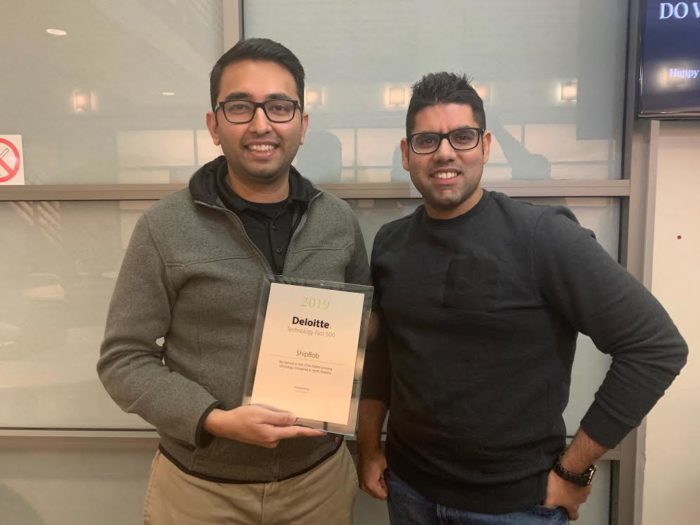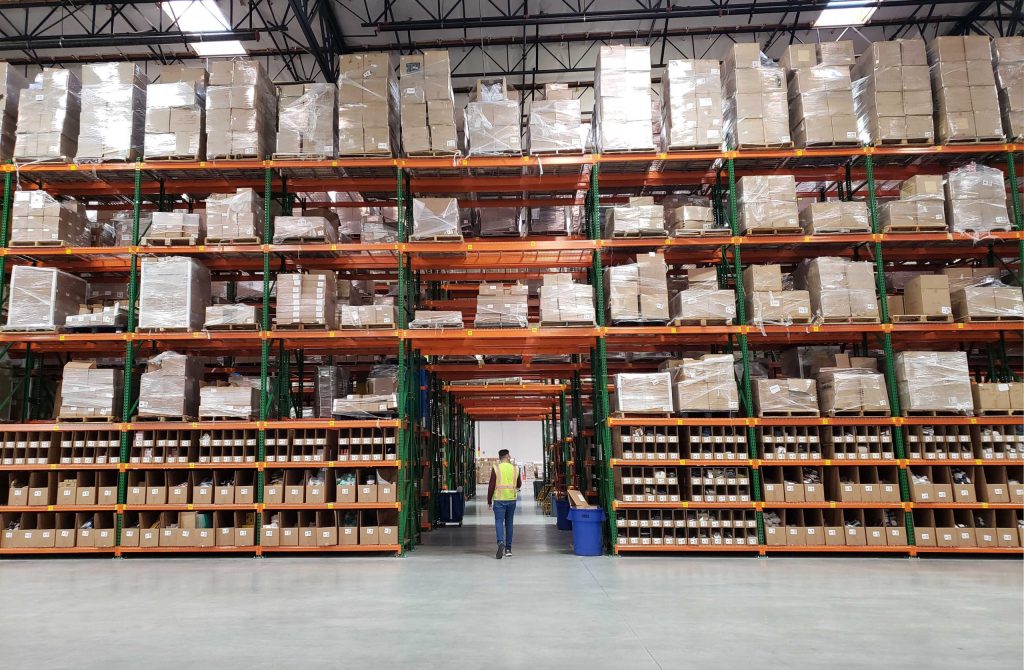Table of Contents
** Minutes
Looking back at the first five years
Always growing, always improving
ShipBob’s CEO and Co-Founder Dhruv Saxena and Chief Logistics Officer Todd Bills joined us this week for Episode 10 of our “Moving Your Business Forward” weekly webinar series. Dhruv reflected on how ShipBob got started and where we’re heading. Todd offered insight into what it takes to build an efficient fulfillment infrastructure, and how it’s always evolving.
The webinar attendees (ecommerce owners and operators) asked some very good questions that made ShipBob think back on the good and the bad, sharing both successes and the mistakes we’ve made along the way.
Click below to watch the full episode:
Here are some of the biggest highlights:
Looking back at the first five years
ShipBob is celebrating its sixth anniversary next week. During the first five years, ShipBob’s founders, Dhruv Saxena and Divey Gulati, focused their time and energy into building a foundation. They grew up in India together and came to the United States in 2007, both graduating with a degree in engineering. As engineers, they’re always looking for ways to automate pretty much anything.
They started a few ecommerce companies together and, like many of our merchants have experienced, found themselves standing in line at the post office in the Willis Tower in Chicago with a load of orders to ship.
Dhruv and Divey noticed a massive gap in fulfillment services for direct-to-consumer brands, so they started asking other people in line at the post office two questions:
- If there was a service that would take care of fulfillment for you, would you stop coming to the post office?
- How much would you be willing to pay for fulfillment services?
Based on the responses, it was clear how massive the problem was.
What ecommerce brands often don’t realize is putting fulfillment infrastructure in place is expensive, and there’s a lot more to it than packing boxes and shipping orders.
Between racking, managing inventory, and investing in equipment, every time you reach higher order volumes, the cost per order increases. It’s not uncommon for brands to miscalculate how much it’s going to cost them to do it all themselves — and it’s not just money, it’s time too.
We were accepted into the Y-Combinator program, completed it in Spring 2014, and brought our idea of building a fulfillment service for growing direct-to-consumer brands to life.
Our goal was (and still is) to help ecommerce brands of all sizes be successful online with access to a fulfillment infrastructure that allows them to “do it themselves” while saving on costs, time, and energy.
DTC brands shouldn’t have to build the fulfillment infrastructure themselves — that’s why we continuously work on building and expanding the infrastructure that works for all ecommerce brands.
“We want to be the de facto standard of shipping and logistics for ecommerce”
Dhruv Saxena, CEO and Co-Founder of ShipBob
Soon after ShipBob opened its first Chicago fulfillment center, Dhruv and his small team found a nice-looking location in Brooklyn, which they initially thought would be perfect due it its close proximity to so many New Yorkers.
Looking back, it probably wasn’t the best idea to sign a multi-year lease on the fifth floor with an elevator that could only hold one palette at a time, but it got the company to where it is today.
Always growing, always improving
We’re constantly evaluating our efficiencies. Our focus is on reducing the variable cost per order (VCPO), which we report on each month so our entire team has insight into it. We don’t focus on what fulfillment centers are the most efficient but rather learn from each of our locations so we can collectively get better and be more efficient.
“Our goal is to help control our costs to deliver a better service and full stack for our merchants. We know where we play really well, where to be cost-effective, and we’re transparent on where we need to make improvements.”
Todd Bills, Chief Logistics Officer at ShipBob
The benefit of being a tech-enabled fulfillment provider is having access to data. One way we use data is to identify where packages across our network are being shipped. This allows us to make better decisions on where our next fulfillment center location should be, which ultimately reduces average shipping zones, shipping costs, and transit times for our customers.
Ten fulfillment center locations later, thousands of ShipBob customers, millions of orders being shipped each month, and a team of extraordinary employees, our team is incredibly grateful for everyone involved in building an amazing company that merchants want to partner with and employees want to work for.
What COVID-19 taught us as a company

You really don’t know how strong your team is until you go through something significant like a global pandemic. We’ve taken the pandemic very seriously from the beginning, from ordering our employees in our Chicago headquarters to work from home in mid-March to being proactive and beginning fulfillment center contingency planning back in February.
Our fulfillment center leaders and associates have put in the extra time to prepare, change processes, and problem solve on how to stay fully operational while staying safe.
We continue to do everything we can to make our buildings safe and keep our staff safe, we continue to require PPE for all staff (as we have for the past nine weeks), conduct heightened cleaning, and even require PPE for all carrier partners in our yards who are not allowed in the buildings.
The last several months have proved that much of the hard work in the last six years is truly paying off. During this time, we’ve also grown and expanded, seeing order volume increases each week, greater than what we handled in peak season 2019 when we had months to plan for it.
In this time, we’ve been able to hire over 150 people and add more shifts, and we plan to hire another 100. Maneuvering through this challenging situation while being able to thrive, adapt, and grow has been a continuous learning lesson.
One of the many benefits of splitting inventory across multiple ShipBob fulfillment centers is that if one fulfillment location needs to shut down for any reason, orders can be fulfilled by a secondary location. It requires more cost upfront but is often outweighed by servicing the end customer by getting the packaged shipped and delivered on time.
We listened closely to what our merchants’ challenged and what they needed during COVID-19 and our focus was to fully support them in however way we can during these trying times. We continue to actively communicate with all stakeholders, keeping them informed throughout COVID-19, from prioritizing essential products to carrier updates and delays.

We came together to help the entire ecommerce industry during these times, promoting COVID-19 resources, aggregating ecommerce sales trends data for merchants, and launching the COVID-19 advice webinar series.
It also led us to launch the ShipBob Giving Fund that supports our fulfillment center employees during hardships, which will continue to be an active funding source.
All these efforts factored into our full business continuity plan that would have never been possible without the perseverance of our team.
“We are so thankful to our team in the fulfillment centers who are risking their lives and the health of their families to support our thousands of merchants, their tens of thousands of employees, and the millions of people across the world who are receiving these essentials and other items from your stores.”
Dhruv Saxena, Co-Founder and CEO of ShipBob (an expert from here)
Scaling while staying true to our mission

ShipBob is heading into an exciting new chapter, focusing on how to scale without compromising today’s merchant experience. The first several fulfillment center locations were owned and operated by us, and the next six are owned by us but still utilize our proprietary technology, which has allowed ShipBob to expand our capabilities without losing sight of what makes ShipBob a premium shipping and fulfillment service.
“If you’re an ecommerce brand, my advice to you is this: Keep at it! Even if it gets hard. This is a massive space. Especially during the early stages, don’t give up.”
Dhruv Saxena, Co-Founder and CEO of ShipBob
Our merchants can distribute inventory across multiple locations in the US, as well as in our international fulfillment center locations (Australia, Canada, and Europe), and still track the entire fulfillment process from a single dashboard.
No matter how much we grow and scale, we always keep our customers in mind — making sure that they have what they need to scale their business, all from launching new integrations to new fulfillment locations.



